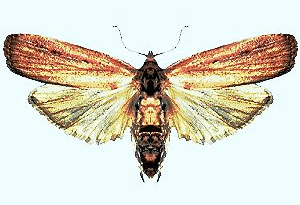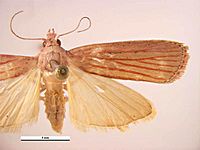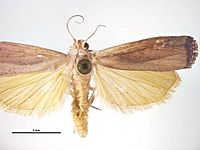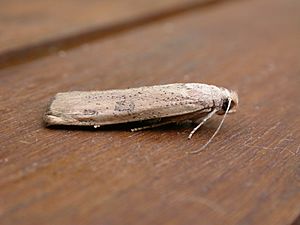Coconut spike moth facts for kids
Tirathaba rufivena, also known as the coconut spike moth or oil palm bunch moth, is a type of moth from the family Pyralidae. You can find this moth in many places, from Southeast Asia to the Pacific islands. This includes countries like Malaysia, the Cook Islands, the Philippines, and tropical parts of Queensland, Australia. These moths are usually considered a minor pest, meaning they can cause some damage to plants, but not usually a lot.
Quick facts for kids Coconut spike moth |
|
|---|---|
 |
|
| Scientific classification | |
| Genus: |
Tirathaba
|
| Species: |
rufivena
|
| Synonyms | |
|
|
What Does the Coconut Spike Moth Look Like?
This moth has a wingspan of about 26 to 30 millimeters (about 1 to 1.2 inches). Adult moths have front wings that are dull green or brown. These wings often have thin red stripes running from the edge towards the body. Their back wings are usually a plain pale yellow or orange-yellow color.
Where Do They Live and What Do They Eat?
The young moths, called larvae or caterpillars, are agricultural pests. This means they can harm crops. They like to feed on several important plants, including:
- Coconut palm (Cocos nucifera)
- Nypa palm (Nypa fruticans)
- Oil palm (Elaeis guineensis)
- Banana (Musa species)
- Bean plants (Phaseolus species)
Usually, the caterpillars attack the male flowers of these plants. If there's a serious attack, the plant might wilt, which means it becomes weak and droopy. This can also slow down the plant's growth. It's important to know that these caterpillars don't bore into the plants. They only feed on the outside parts.
How Are These Moths Controlled?
One of the best ways to control these moths is through something called biological control. This method uses other living things, like natural enemies, to fight the pests. It can help control both the larvae (caterpillars) and the eggs.
Scientists use different types of parasites and helpful fungi. For example, fungi like Beauveria bassiana and Metarhizium anisopliae are used in many areas. These fungi can infect and kill the moths.
In Malaysia, a type of wasp called Venturia palmaris has been tested. These wasps attack the moth larvae, especially in November and December. Another insect, a type of fly called Agrophylax basifulva, has been used in Fiji. This fly is a parasitoid, meaning its larvae develop inside the moth larvae, eventually killing them.
Besides biological control, people in many countries also use traditional methods. This includes simply hand-picking the moths or caterpillars off the plants.




